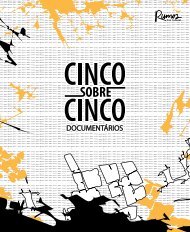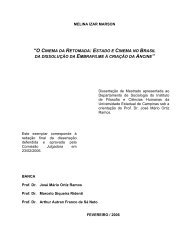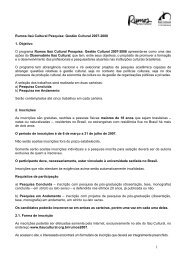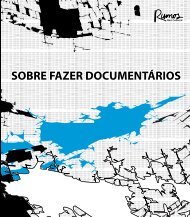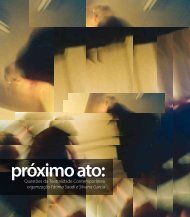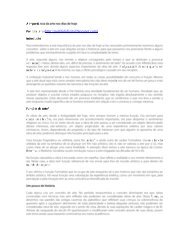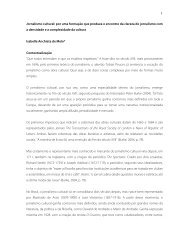PatrÃcia Moran - Itaú Cultural
PatrÃcia Moran - Itaú Cultural
PatrÃcia Moran - Itaú Cultural
You also want an ePaper? Increase the reach of your titles
YUMPU automatically turns print PDFs into web optimized ePapers that Google loves.
produção das bases também é simples materialmente. Paraa criação de seus gráficos e figuras geométricas utiliza oPaintbrush, programa simples oferecido pela Apple no pacotebásico do computador, para imagens fixas. Nesse caso, suamanipulação consiste em retirar cores e aproximar as figurasdesenhadas. A câmera varre a tela, percorre a superfície daimagem da televisão, segue linhas, desenha percursos, revelasempre o mesmo: uma linha a se percorrer. A música deXabier Erkizia, com quem ele realiza esse trabalho, enfatiza asmarcações cíclicas da imagem.Benedetti trabalha com ciclos. O release de sua performancea coloca como um concerto em quatro movimentos.Conhecedor de ópera e música clássica, ele costuma seapresentar com maestros em concertos tradicionais. Suaperformance visual traz da música a abstração, a circularidadedos temas, uma espécie de ritornelo, entendido aquialém da repetição, como momento da música em que háum retorno do coro. No trabalho de Benedetti a temporalidadeestabelece ciclos e repetições. A repetição de pontos,de cada vez mais pontos, mas não a repetição do mesmo. Oritmo instaurado pela repetição pressupõe uma variação, avariação visível é de quantidade. Subjacente à quantidade,instala-se nova qualidade com os ciclos. Algo muda em ciclos,algo muda discreto, é o rastro na imagem, é o aumentodos círculos. O concerto ao qual estou me referindo integroua programação do On_Off, no Itaú <strong>Cultural</strong>. Simples e engenhoso,o segundo movimento do concerto era composto degotas, uma evolução delas. A base técnica das mesmas é orecurso scroll de programas de edição; o scroll, assim como atable top, foi originalmente desenvolvido para a animação deletreiros, para criar movimentos verticais ou horizontais doscréditos. Benedetti lança mão do scroll mas, em vez de letraspercorrendo verticalmente a tela, há uma dança de pontosfinais. Uma bola branca sobe pela tela e repete o movimentodeixando um rastro. A quantidade de bolas cresce e diminuiseu tamanho. Nesse trabalho, temos o desenho a emular amúsica na marcação temporal.A performance de Santos conta no palco com uma “caixa”de telas dentro da qual as atrizes Maria Luísa Mendonça eMônica Ribeiro se revezam na leitura e encenação bastanteposada de um texto nonsense. Não fosse a força das imagensprojetadas e o diálogo da música de Josefina Cerqueira ePaulo Santos com as atrizes, haveria o risco de a performancetransformar-se em um evento teatral. Os sons, os ruídos eas vozes estão em toda parte. Os corpos irrompem gritando.A baixa resolução da tela e a sobreposição da imagem dasatrizes com a projeção não nos autoriza a humanizar aquelescorpos. São vultos, são pulos, são formas femininas com lonwithits bases. The controls of the camera speed, scale andcolor are performance features. The production of the basesis also simple in material terms. For the creation of his graphsand geometric figures, he uses Paintbrush, a simple programprovided by Apple in a basic computer package for stillimages. In this case, his manipulation consists in removingcolors and approaching the drawn figures to each other. Thecamera scans the screen, goes through the television imagesurface, follows lines, draws circuits, always reveals the same:a line to go through. The music of Xabier Erkizia, his partner inthis venture, emphasizes the cyclic image indications.Benedetti works with cycles. His performance press releaseputs it as a four-movement concerto. A connoisseur of operaand classical music, he performs together with conductorsin traditional concerts. His visual performance takes frommusical features like abstraction, theme circularity, a type ofritornello, which is understood here to go beyond repetition,as a moment in the piece of music in which there is a recurrentpassage for the chorus. In Benedetti’s work, temporality setscycles and repetitions. The repetition of points, increasinglymore points, not the repetition of the same, though. Therhythm triggered by the repetition makes one assume theexistence of a variation, the visible variation refers to quantity.Underlying such quantity, a new quality is established withthe cycles. Something changes in cycles, something changesdiscreetly, it is the image track, it is the increase in circles. Theconcerto I am referring to took part in the On_Off programheld at Itaú <strong>Cultural</strong>. Simple and ingenious, the concertosecond movement was composed of drops, an evolutionof drops. Their technical base is the scroll feature in editingprograms; the scroll, just like the tabletop, was originallydeveloped for title animation to create vertical or horizontalmovements of credits. Benedetti resorts to scroll but, insteadof letters running the screen vertically, it shows a dance ofperiods. A white ball climbs up the screen and repeats themotion leaving a track. The number of balls increases whiletheir size reduces. In this work, the drawing emulates themusic piece according to the marking of tempo.In the previous performances mentioned, abstraction resultsfrom saturation, it is in the organization of the expressiveelements, in the superimposition and juxtaposition of materialNas performances anteriormente mencionadas, a abstraçãoé resultado da saturação, está na organização dos elementosexpressivos, na sobreposição e justaposição material e desentidos, de registros sonoros e visuais, enfim, vem do excesso.Aqui os elementos utilizados já são abstratos, a imageme o ritmo rarefeitos: estamos diante da temporalização daimagem, de uma performance sustentada pela sucessão, porciclos audiovisuais.No outro extremo, em termos tecnológicos, o espanhol radicadoem São Paulo Nacho Duran realiza suas performancesora com o aplicativo Randox, por ele desenvolvido, ora comPure Data (PD), linguagem de programação com respostaem tempo real. A programação costuma ser realizada porFernando Velásquez, uruguaio também residente no Brasil.A abstração criada é próxima à de linguagens semelhantes,antecessoras da PD, como o Max_jitter, desenvolvimentodo lendário Nato. 8 A performance de Duran explora principalmenteo quadro e a decomposição das formas, recursorecorrente nessas linguagens. No Randox, como sugere onome do aplicativo, serão geradas combinações aleatórias,ou seja, randômicas; com o PD, as imagens escorrem segundoprogramação em tempo real, com o descontrole humanodos processos autogenerativos.A potência da explosãoFinalmente, faremos uma rápida passagem pelas performancesA Place Where No Cars Go, de Eder Santos, e Concerto paraLaptop: Sem Título, de Luiz Duva, conhecido como VJ duVa.Interessa-nos como esses trabalhos transformam o eventoem pura potência. Quando dizemos potência nos referimosa uma força irregular em termos de frequência. Se nas performancesde Benedetti havia harmonia na repetição, aqui háirregularidade. A potência também está nas explosões quepontuam os espetáculos.and meanings, of sound recording and footage, to sum up, itresults from excess. Here, the elements utilized are abstract tostart with, the image and the rhythm are scarce: we are beforethe image temporalizing, before a performance sustained bysuccession, by audiovisual cycles.On the other end, in technological aspects, Spanish artistliving in Sao Paulo Nacho Duran makes his performances byusing either the Randox application, which he developed,or Pure Data (PD), a programming language with realtimeresponse. The programming is usually carried out byFernando Velásquez, a Uruguayan also living in Brazil. Theresulting abstraction is close to that of similar languages, PD’spredecessors, such as Max_jitter, developed by legendaryNato. 8 Duran’s performance explores particularly the frameand the decomposition of shapes, a recurrent feature of theselanguages. In Randox, as the application name suggests, theoutcome is focused on generating random combinations;with PD, the images flow according to real-time programmingwith the human decontrol of autogenerative processes.The power of explosionLastly, we shall catch a sight of the performances A Place WhereNo Cars Go, by Eder Santos, and Concerto para Laptop: SemTítulo, by Luiz Duva, a.k.a. VJ duVa. Our interest lies in how theseworks turn the event into pure power. By mentioning power,we are referring to an irregular power as far as frequency isconcerned. While in Benedetti’s performances the repetitiontook place in harmony, in this case, it is uneven. The power isalso seen in the explosions scattered throughout the shows.Santos’s performance presents on the stage a “box” of screensinside of which actresses Maria Luísa Mendonça and MônicaRibeiro take turns reading and acting out a nonsense textwith strong emphasis on poses. Were it not for the strengthconveyed by the images projected and the dialog of JosefinaCerqueira’s and Paulo Santos’s music with the actresses, theperformance could run the risk of being transformed into atheatrical event. The sounds, the noises, and the voices areeverywhere. The bodies burst into yelling. The low screenresolution and the superimposition of the actresses’ imagewith the projection do not empower us to humanize thosebodies. They are figures, they are hops, they are long-haired84 85



